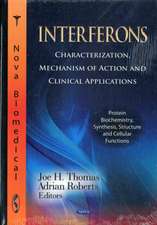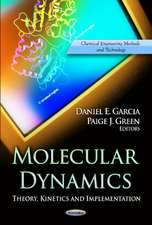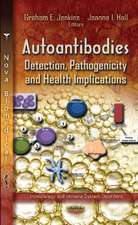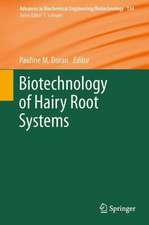Selenium: Its Molecular Biology and Role in Human Health
Editat de Dolph L. Hatfield, Ulrich Schweizer, Petra A. Tsuji, Vadim N. Gladysheven Limba Engleză Hardback – 22 sep 2016
| Toate formatele și edițiile | Preț | Express |
|---|---|---|
| Paperback (1) | 1618.90 lei 6-8 săpt. | |
| Springer International Publishing – 26 iun 2018 | 1618.90 lei 6-8 săpt. | |
| Hardback (1) | 1626.41 lei 6-8 săpt. | |
| Springer International Publishing – 22 sep 2016 | 1626.41 lei 6-8 săpt. |
Preț: 1626.41 lei
Preț vechi: 1712.00 lei
-5% Nou
Puncte Express: 2440
Preț estimativ în valută:
311.26€ • 323.75$ • 256.96£
311.26€ • 323.75$ • 256.96£
Carte tipărită la comandă
Livrare economică 14-28 aprilie
Preluare comenzi: 021 569.72.76
Specificații
ISBN-13: 9783319412818
ISBN-10: 3319412817
Pagini: 580
Ilustrații: XXXI, 628 p. 88 illus., 59 illus. in color.
Dimensiuni: 155 x 235 x 37 mm
Greutate: 1.1 kg
Ediția:4th ed. 2016
Editura: Springer International Publishing
Colecția Springer
Locul publicării:Cham, Switzerland
ISBN-10: 3319412817
Pagini: 580
Ilustrații: XXXI, 628 p. 88 illus., 59 illus. in color.
Dimensiuni: 155 x 235 x 37 mm
Greutate: 1.1 kg
Ediția:4th ed. 2016
Editura: Springer International Publishing
Colecția Springer
Locul publicării:Cham, Switzerland
Cuprins
Part I. The machinery of selenoprotein biosynthesis.- 1 Selenocysteine tRNA[Ser]Sec: From nonsense suppressor tRNA to the quintessential constituent in selenoprotein biosynthesis.- 2 Eukaryotic mechanisms of selenocysteine translation and its reconstitution in vitro.- 3 Probing selenoprotein translation by ribosome profiling.- 4 Pathways in de novo biosynthesis of selenocysteine and cysteine in eukaryotes.- 5 Prokaryotic selenoprotein biosynthesis and function.- 6 The role of selenium in human evolution.- 7 The chemistry of selenocysteine in proteins.- 8 Evolution of selenophosphate synthetase.- 9 Structure and mechanism of selenocysteine synthases.- 10 Mechanism, structure, and biological role of selenocysteine lyase.- Part II. Selenoproteins, their occurrence and function.- 11 Eukaryotic selenoproteomes.- 12 Prokaryotic selenoproteins and selenoproteomes.- 13 Functional genomics of selenoproteins and Se-responsive pathways.- 14 Selenium regulation of the selenoprotein and non-selenoprotein transcriptomes in a variety of species.- 15 77Se NMR spectroscopy of selenoproteins.- 16 Thioredoxin reductase 1 as an anticancer drug target.- 17 Basics and news on glutathione peroxidases.- 18 Glutathione Peroxidase 4.- 19 The 15 kDa Selenoprotein: Insights into its regulation and function.- 20 Selenoprotein K and protein palmitoylation in regulating immune cell functions.- 21 Selenoprotein M: Structure, expression and functional relevance.- 22 Selenoprotein P and selenium distribution in mammals.- 23 Selenoprotein T: From discovery to functional studies using conditional knockout mice.- 24 Biochemistry and function of methionine sulfoxide reductase.- Part III. Dietary selenium and its impact on human health.- 25 Selenium: Dietary sources, human nutritional requirements and intake across populations.- 26 Human clinical trials involving selenium.- 27 Status of dietary selenium in cancer prevention.- 28 Selenium in HIV/AIDS.- 29 Genetic variations in the genes for selenoproteins implicate the encoded proteins in cancer etiology.- 30 Is adequate selenium important for healthy human pregnancy?.- 31 The epidemiology of selenium and human health.- 32 Sex-specific differences in biological effects and metabolism of selenium.- 33 Selenium and endocrine tissues.- 34 Selenium antagonism with mercury and arsenic: from chemistry to population health and demography.- 35 Biological selenium species and selenium speciation in biological samples.- 36 Selenoproteins in nervous system development, function and degeneration.- 37 Interplay of selenoproteins and different antioxidant systems in various cancers.- 38 Glutathione peroxidase 2, a selenoprotein exhibiting a dual personality in preventing and promoting cancer.- 39 Selenoproteins in cardiovascular redox pathology.- 40 What do we know about selenium contributions to muscle physiology?.- 41 Tissue-specific regulation of thyroid status by selenodeiodinases.- 42 The role of selenoproteins in resolution of inflammation.- 43 Glutathione peroxidase 4 and ferroptosis.- 44 Mutations in humans that adversely affect the selenoprotein synthesis pathway.- 45 Alteration of selenoprotein expression during stress and in aging.- Part V. Biological models for elucidating the role of selenium and selenoproteins in biology and medicine.- 46 Selenocysteine tRNA[Ser]Sec mouse models for elucidating roles of selenoproteins in health and development.- 47 Mouse models that target individual selenoproteins.- 48 The naked mole rat and selenium.- 49 Glutathione peroxidase 1: Models for diabetes and obesity.- 50 Selenium in livestock and other domestic animals
Recenzii
“The book provides up to date and comprehensive review of hot topics in the field of Se research and is the source of valuable information for people working in science, clinics and industry.” (Jela Brozmanova, Neoplasma, Vol. 64 (3), 2017)
Notă biografică
Dolph Hatfield is Scientist Emeritus in the Molecular Biology of Selenium Section at the National Cancer Institute.
Ulrich Schweizer, is Professor at the Institute of Biochemistry and Molecular Biology, Rheinische Friedrich-Wilhelms-Universität Bonn.
Petra Tsuji is Assistant Professor in the at the Department of Biological Sciences at Towson University.
Vadim N. Gladyshev, is Professor in the Division of Genetics, Department of Medicine at the Brigham and Women’s Hospital and Harvard Medical School.
Ulrich Schweizer, is Professor at the Institute of Biochemistry and Molecular Biology, Rheinische Friedrich-Wilhelms-Universität Bonn.
Petra Tsuji is Assistant Professor in the at the Department of Biological Sciences at Towson University.
Vadim N. Gladyshev, is Professor in the Division of Genetics, Department of Medicine at the Brigham and Women’s Hospital and Harvard Medical School.
Textul de pe ultima copertă
In the current edition, Selenium: Its Molecular Biology and Role in Human Health expands extensively on the previous editions providing readers with the most significant advances in the rapidly developing selenium field. Evidence from epidemiology and veterinary science supports the essential role of selenium in (human) health, but its split personality in both preventing and supporting cancer and also in promoting insulin resistance has become more clearly defined. The pivotal role of glutathione peroxidase 4 in a new process of programmed cell death, ferroptosis, brings new impetus to the field. Recently defined mutations in selenoprotein and biosynthesis factor genes have been identified in patients, and the resulting disorders further emphasize the significance of selenoproteins in human health. The mechanism of selenoprotein biosynthesis, the functions of selenoproteins, and the roles of dietary selenium have been further elucidated, and new regulatory mechanisms involving selenoproteins discovered. The book, therefore, covers the breadth of current selenium research. With up-to-date chapters written by leaders in their fields, it serves as an invaluable resource for novices as well as specialists.
Caracteristici
Provides an overview of the health benefits of Selenium
Brings the research on selenium up-to-date
Provides an in depth reference for those entering the selenium field
Includes supplementary material: sn.pub/extras
Brings the research on selenium up-to-date
Provides an in depth reference for those entering the selenium field
Includes supplementary material: sn.pub/extras











